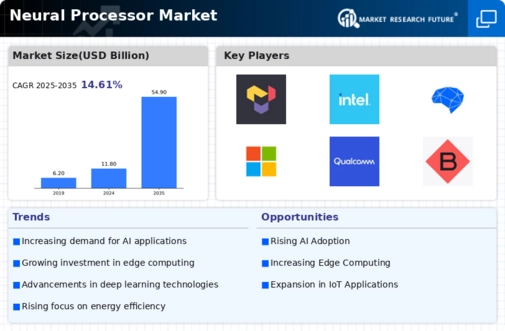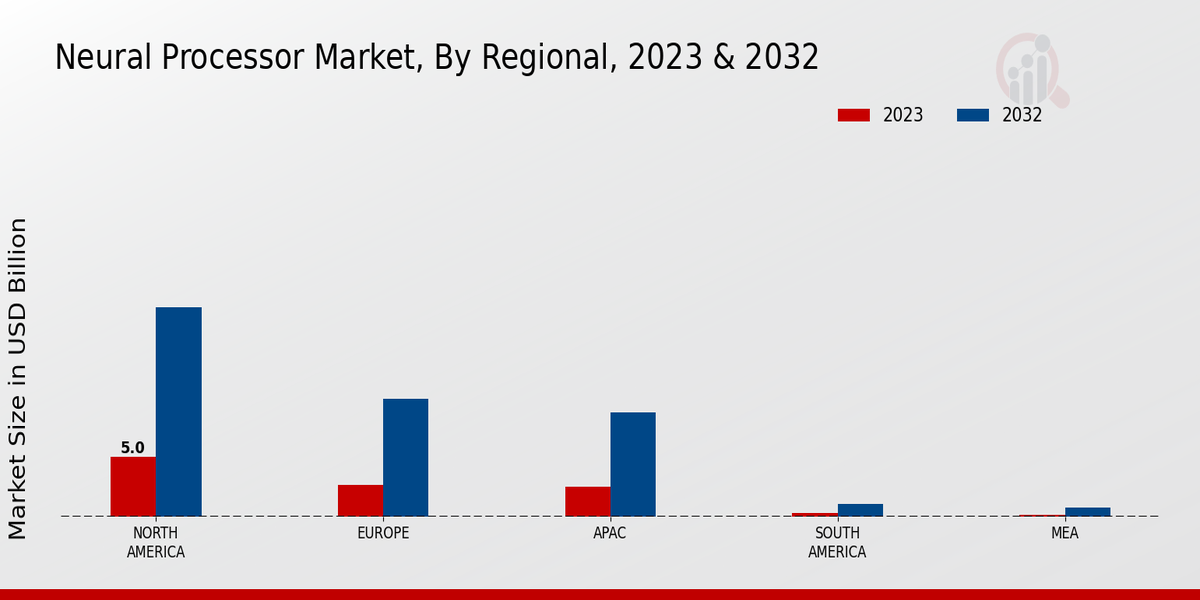Market Growth Projections
The Global Neural Processor Market Industry is projected to experience substantial growth over the coming years. With a market valuation expected to reach 11.8 USD Billion in 2024 and an anticipated increase to 54.9 USD Billion by 2035, the industry is on a robust upward trajectory. This growth is underpinned by a compound annual growth rate of 14.98% from 2025 to 2035. Such projections indicate a strong demand for neural processors driven by advancements in AI, machine learning, and emerging technologies, positioning the industry for significant expansion in the global market.
Emergence of 5G Technology
The rollout of 5G technology is poised to have a transformative impact on the Global Neural Processor Market Industry. With its promise of ultra-fast data transmission and low latency, 5G enables more sophisticated applications that require real-time processing capabilities. Industries such as telecommunications and smart cities are leveraging 5G to deploy advanced AI solutions, which in turn drives the demand for neural processors. As 5G networks become more widespread, the market is likely to see accelerated growth, as organizations capitalize on the enhanced capabilities offered by this next-generation technology.
Advancements in Machine Learning
Technological advancements in machine learning are significantly influencing the Global Neural Processor Market Industry. As algorithms become more sophisticated, the need for specialized hardware that can efficiently execute these algorithms is paramount. Neural processors are designed to handle complex computations, enabling faster training and inference times for machine learning models. This trend is evident in sectors like finance, where predictive analytics is becoming increasingly reliant on neural processing capabilities. The market is anticipated to grow at a CAGR of 14.98% from 2025 to 2035, reflecting the critical role of neural processors in the evolution of machine learning technologies.
Rising Demand for AI Applications
The Global Neural Processor Market Industry is experiencing a surge in demand driven by the increasing adoption of artificial intelligence applications across various sectors. Industries such as healthcare, automotive, and finance are integrating AI technologies to enhance efficiency and decision-making processes. For instance, AI-driven diagnostic tools in healthcare are improving patient outcomes, while autonomous vehicles rely on neural processors for real-time data processing. This growing reliance on AI is projected to propel the market to a valuation of 11.8 USD Billion in 2024, indicating a robust growth trajectory as organizations seek advanced processing capabilities.
Growing Adoption of Edge Computing
The shift towards edge computing is reshaping the Global Neural Processor Market Industry, as organizations seek to process data closer to its source. This trend is particularly relevant in IoT applications, where low latency and real-time processing are essential. Neural processors are increasingly being integrated into edge devices, enabling them to perform complex computations without relying on centralized cloud resources. As more industries adopt edge computing solutions, the demand for efficient neural processors is expected to rise, further driving market growth. This evolution reflects a broader trend towards decentralized computing architectures, which are likely to dominate the future landscape.
Increased Investment in Research and Development
Investment in research and development within the Global Neural Processor Market Industry is on the rise, as companies strive to innovate and enhance their product offerings. Governments and private entities are allocating substantial resources to develop next-generation neural processors that can outperform existing technologies. For example, initiatives aimed at creating energy-efficient processors are gaining traction, as sustainability becomes a priority. This focus on R&D is likely to contribute to the market's growth, with projections indicating a market size of 54.9 USD Billion by 2035, underscoring the importance of continuous innovation in this competitive landscape.













